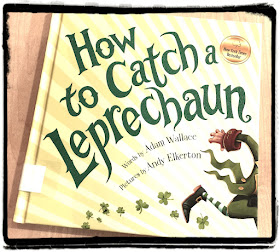I'm a little behind on my blogging, so I apologize for the delay in posting about a recent third grade lesson from St. Patrick's Day! Third grade teachers wanted to take a few minutes for a fun St. Patrick's Day activity, so they asked for my help to provide a digital option. I began the lesson with a class read-aloud of the fabulous new picture book, How to Catch a Leprechaun written by Adam Wallace and illustrated by Andy Elkerton.
This book, with it's rhyming plot and delightfully naughty little leprechaun is a perfect class read-aloud! But my favorite part of this picture book is the ending. Readers are invited to design their own leprechaun trap for next year!
This created the perfect segue for students to design their own leprechaun trap using the design elements from Rube Goldberg's machines! You may be wondering, What is a Rube Goldberg machine? Rube Goldberg was a a Pulitzer Prize winning cartoonist who was trained as an engineer. He create many cartoons and became most famous for his zany cartoons of complex machines with chain reactions designed to do simple tasks!
Here is a prime example and one of his most famous machines was the Self Operating Napkin...
Once I shared the story of Rube Goldberg, I shared my favorite example of a Rube Goldberg machine in action! This is a great example because it demonstrates an elementary child (someone our students can relate to) enthusiastically testing his Rube Goldberg machine.
We used YouDoodle, our "go to" free drawing iPad app as the drawing tool for designing. It has helpful grid line that help the user manage the drawing space. I also gave students a stylus to help them control their lines. Their products demonstrated their creative planning! Students shared their leprechaun traps, explaining their chain reactions and thoughtful designs. All of us throughly enjoyed seeing the results! Maybe next year, one of our students will catch a leprechaun!






